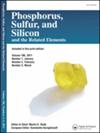Synthesis and characterization of lithium alumina silicate (LiAl(SiO3)2) from naturally sourced silica: a comparative study
IF 1.4
4区 化学
Q4 CHEMISTRY, INORGANIC & NUCLEAR
Phosphorus, Sulfur, and Silicon and the Related Elements
Pub Date : 2024-09-02
DOI:10.1080/10426507.2024.2416204
引用次数: 0
Abstract
This study investigates the synthesis and characterization of lithium aluminosilicate (LiAl(SiO3)2) using naturally sourced silica (NSS) from the Djamâa region in Algeria and compares it with laboratory-sourced silica (LSS). The synthesis was conducted using the sol–gel method and solid-state reactions with lithium carbonate, aluminum oxide, and SiO2. Characterization techniques included X-ray diffraction (XRD), Fourier-transform infrared spectroscopy (FTIR), and scanning electron microscopy (SEM). XRD analysis confirmed the crystalline structure of the synthesized lithium aluminosilicate, revealing distinct crystal phases: the NSS material exhibited a tetragonal spodumene-II phase. In contrast, the LSS material showed a hexagonal spodumene-III phase. The crystallite sizes were 21.96 μm for NSS and 22.14 μm for LSS, with crystallinity percentages of 60.77% and 57.55%, respectively. FTIR spectroscopy verified the successful incorporation of lithium and aluminum into the silica framework. SEM analysis provided detailed insights into surface morphology and particle size distribution, highlighting the uniformity of the materials. Specifically, the LSS material exhibited cylindrical spaces between particles, whereas the NSS material displayed spherical spaces.
以天然二氧化硅为原料合成硅酸锂铝(LiAl(SiO3)2)的比较研究
本研究利用阿尔及利亚djam地区的天然二氧化硅(NSS)合成和表征了铝硅酸锂(LiAl(SiO3)2),并将其与实验室来源的二氧化硅(LSS)进行了比较。采用溶胶-凝胶法,以碳酸锂、氧化铝、SiO2为原料进行固相合成。表征技术包括x射线衍射(XRD),傅里叶变换红外光谱(FTIR)和扫描电子显微镜(SEM)。XRD分析证实了合成的铝硅酸锂的晶体结构,显示出明显的晶体相:NSS材料呈现出四方锂辉石- ii相。相比之下,LSS材料呈现六方锂辉石- iii相。NSS和LSS的晶粒尺寸分别为21.96 μm和22.14 μm,结晶度分别为60.77%和57.55%。FTIR光谱验证了锂和铝成功结合到二氧化硅框架中。扫描电镜分析提供了对表面形貌和粒度分布的详细见解,突出了材料的均匀性。具体来说,LSS材料在粒子之间表现出圆柱形空间,而NSS材料则表现出球形空间。
本文章由计算机程序翻译,如有差异,请以英文原文为准。
求助全文
约1分钟内获得全文
求助全文
来源期刊
CiteScore
2.60
自引率
7.70%
发文量
103
审稿时长
2.1 months
期刊介绍:
Phosphorus, Sulfur, and Silicon and the Related Elements is a monthly publication intended to disseminate current trends and novel methods to those working in the broad and interdisciplinary field of heteroatom chemistry.

 求助内容:
求助内容: 应助结果提醒方式:
应助结果提醒方式:


